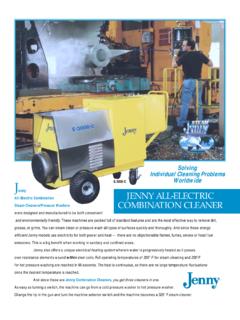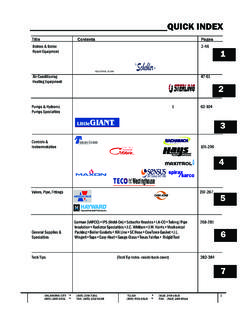Transcription of MATERIALS ISSUES FOR TURBINES FOR OPERATION IN …
1 MATERIALS ISSUES FOR TURBINES FOR OPERATION IN ULTRA-SUPERCRITICAL Wrighta, Maziasza, Ellisb, Gibbonsc, and WoodforddABSTRACTCoal-fired supercritical- steam power plants are currently operating with steam temperatures at the inlet tothe high-pressure turbine close to or slightly above 600 C. The use of recently-developed martensitic-ferritic steels is expected to allow this temperature to be raised to 620 C, which probably represents theinherent limit of capability of these advanced steels. Further increases in temperature capability willrequire the use of Ni-base alloys, and efforts in this direction have been pioneered in Europe where thereare plans to build a plant operating on steam at 700 C.
2 In the , there is a significant effort aimed atqualifying alloys that could be used for tubing and piping to deliver steam at 720/760 C. In this paper,the technical and business considerations involved in determining and prioritizing the MATERIALS needs forturbines operating under these ultra-supercritical steam conditions are is widely recognized that, because of the very large role that coal plays in power generation, efforts toreduce overall CO2 emissions will, of necessity, involve efforts to find cleaner ways in which to use carbon from coal before or after combustion introduces costs that seriously detract from thecompetitiveness of that power generation process.
3 If the efficiency of the overall cycle were to beimproved, however, less CO2 would be produced for each unit of electricity typical supercritical steam practice, steam is delivered to the turbine at temperatures up to 566 Cand at a typical pressure of 238 bar. There is experience in the of OPERATION at higher steamconditions: Philo Unit 6 of American Electric Power (started up in 1957) operated with steam at621 C/310 bar, with two reheats to 566 C1. In addition, Eddystone Unit 1 of the Philadelphia ElectricCompany (started up in 1961) operated with steam conditions of 649 C/340 bar, with double reheats to566 C2.
4 Both were relatively small units by modern standards, 125 and 325 MW, respectively; the sizewas essentially determined by the size of the austenitic steel high-pressure rotor that could be made at thetime3. The steam TURBINES were manufactured by General Electric (GE) and Westinghouse, were experienced with these early, pioneering units, some of which were MATERIALS related, andthese contributed to a decision to derate to less ambitious steam conditions to improve supercritical plants in the employed steam conditions which are typically 541-566 C/238bar.
5 As of 1986, some fifteen percent of the fleet of operating steam power plants used asupercritical steam cycle, and these are mostly 1960s-1970s-vintage units4. The TURBINES installed in supercritical fleet were manufactured principally by GE and Westinghouse, with some from theBrown Boveri , there has been a gradual push for the use of steam conditions in advance of those generallyused in the As an example, the Aved re Unit 2 Power Station of the SK Power Company inDenmark, which started commercial OPERATION at the beginning of 2001.
6 Operates with a main steam a Oak Ridge National Laboratoryb Tordonato Energy Consultantsc Consultant to ORNLd MPa of 582 C, at 300 bar, with a single heat reheat to 600 C5. The turbine used in this case wassupplied by Ansaldo Energia. The MATERIALS development to support these advances has come from majorprograms in Europe5 and Japan,6 with support from EPRI7. The overall strategy employed was to useferritic-martensitic steels to their maximum temperature capability, and then to switch to Ni-based alloysfor the final sections of the steam generator, so avoiding the need to use austenitic stainless steels and theassociated problems of dissimilar metal joints and susceptibility to thermal fatigue that arise from thecoefficient of expansion mismatch and low thermal conductivity of these alloys.
7 While significantimprovements in the temperature capability of ferritic-martensitic steels have been achieved, it appearsthat the limit for the strengthening mechanisms currently employed will be of the order of 620 C8. Thisis based on a criterion of a stress rupture strength of 100 MPa for 105 hrs to allow the use of sufficientlythin section thicknesses to minimize thermal fatigue concerns. As a result, the high cost of the higher-strength Ni-based alloys will likely lead to the development of cheaper CASE FOR ULTRA-SUPERCRITICAL STEAMThe efficiency of the Carnot cycle is defined as (Tmax-Tmin)/Tmax, (where Tmax is the maximum temperaturein the thermodynamic cycle, and Tmin is the minimum temperature, both as absolute temperatures).
8 Therefore, the most practical route to increase the efficiency of a coal-fired power plant is to increase themaximum steam temperature; decreasing Tmin is possible only in a few locations, such as Scandinavia,where unusually cold cooling water is available from the Baltic Sea. Figure 1 is an illustration of theextent of improvement possible, as well as the relative effects of increasing steam temperature andpressure9,10. It is claimed that a change from the steam conditions most often used in the (541 C/238bar) to those that form the goal of the Ultra-Supercritical (USC) steam Tubing Consortium(740/760 C/340 bar), results in an increase in overall cycle efficiency of more than five percentage Domestic PerspectiveAs mentioned earlier, some fifteen percent of the 1960s-1970s-vintage fleet of operating steampower plants uses a supercritical steam cycle4.
9 The stigma of lower reliability compared to subcriticalsteam units that resulted from early difficulties with supercritical technology is long past, and these unitsmatch or exceed the reliability of subcritical units of the same vintage11. However, until recently, the lowcost of coal in the has been a major disincentive to investment in the increased efficiency of newsupercritical steam power plants. The current listing of orders placed for coal-fired steam generators inthe contains only three supercritical units, which represent 2 GW of the 51 GW on order.
10 This issurprising, since the major customers for new steam plant are utilities, compared to the predominance ofindependent power producers in the 1990 s, so that the longer-term advantages of the supercritical cyclewould be expected to be an obvious attraction. The supercritical plants on order are the 790 MW CouncilBluffs Unit No. 4 of MidAmerica Energy, Iowa, and two 600 MW units at the Oak Creek station ofWisconsin Energy and Madison Gas. For these, supercritical conditions were mandated by concerns forthe need to decrease emissions of CO2.








